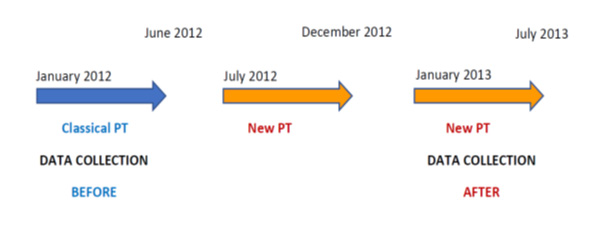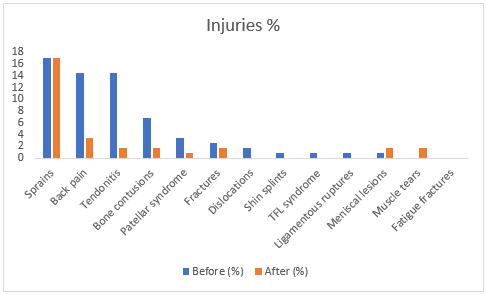- Submissions

Full Text
Orthopedic Research Online Journal
Physical Optimization of the Paratrooper’s Operational Fitness
Sophie Garnier1*, Cyril Vilmant2, David Aloird3, Pascale Mauriège4 and Sandra Joffroy5
1Centre de Recherche Sciences Sociales Sports et Corps (CRESCO), Université P. Sabatier, Toulouse, France
2Faculté des sciences du sport et du mouvement humain, Université P. Sabatier, Toulouse, France
3Service de santé des armées, Fréjus, France
4Department of Kinesiology, Laval University, Québec, Canada
5Faculté des sciences du sport et du mouvement humain, Université P. Sabatier, Toulouse, France
*Corresponding author: Sophie Garnier, Centre de Recherche Sciences Sociales Sports et Corps (CRESCO), Université P. Sabatier, Toulouse, France
Submission: October 27, 2021;Published: November 02, 2021

ISSN: 2576-8875 Volume9 Issue1
Abstract
Purpose: The optimization of the physical condition of the paratrooper responds to a contextual need and operational efficiency as well as to the application of new doctrines. Various jumping techniques create specific physical and technical constraints that can lead to different types of accidents and injuries.
Methods: After acquiring data of sports practices and the effects of training on paratroopers, we implemented concrete and simple measures as part of a « renovated physical », military and sports training. Health data were collected and analyzed by a physiotherapist and medical students.
Results: With no effect on overall performance, the evolution of sports’ practice is slow to become widespread. When implemented, the renovated fitness system allows a marked improvement in sports-related pathologies. The rate of injuries related to sports activity decreased from 65% to 21.7% in the first year. Hyper-solicitation diseases, which accounted for 40% of injuries, fell to 1%.
Conclusion: Finally, the risk of injury at least once a year decreased from 47.86% to 16.24%. However, preventive measures must also be considered individually in order to reduce the risk as much as possible.
Operational relevance: The practice of resistance training must therefore be popularized, as well as the reduction of the weekly mileage running. In general, the diversification and personalization of training must be the focus of our attention in order to achieve a modernization of physical, military and sports training.
Keywords: Operational fitness; Paratroopers; Reduction of injuries
Abbreviations: OPEX: External Operation; PT: Physical Training; RPIMa: Marine Infantry Paratroopers Regiment; HIIT: High Intensity Interval Training; CRF: Cardiorespiratory Fitness
Introduction
The profession of arms is relatively demanding. The soldier is confronted to physical and psychological constraints which increase regularly during the phase of instruction and training and reached their peak in external operation (OPEX).
Working in an emergency, operating in a hostile sector, using your weapon, saving your life danger, being close to death and human distress, are stressors that affect the individual potential immediately and deeply to degrees that can be mitigated by good mental health and good general physical condition. The capacity operational strength of the troops is therefore closely linked to their level of physical preparation. The paratroopers have extreme operational constraints, the jump in itself coupled with the load carried (from 60 to 90kg), this can lead to different types of accidents and injuries [1]. Their physical preparation is precise and demanding. Injuries are still too common. Knapik [2] reported injury incidence in jumping (8/1000), and in operations (19 to 401/1000). However, all injuries incurred by military staff, the largest proportion (ranging from 32%-63%) are associated with engaging Physical Training (PT) and sports [3]. A new training method in application of a new doctrine [4] is implemented in France to optimize physical condition and reduce injuries.
Objectives
a) To evaluate the impact of the new training method on physical conditioning (n=581)
b) To evaluate the impact of a new training method on injuries in paratroopers (n=117)
Methods
After acquiring characteristics of sports practices and effects of training on paratroopers from 8ème RPIMa’s, measures were implemented as part of the new training method [5]. Physical conditioning data were collected from 581 soldiers (age: 20-28 years) before the implementation of the new doctrine training and after 6 months of this training (Figure 1).
Figure 1: Time study diagram.

Among them, 117 soldiers (age: 25±4 years-old, BMI=24±2kg/ m2) followed a renovated program with specially formed and trained supervisors.
The new physical training (7h/week) consisted of 50% Cardiorespiratory fitness (CRF) and 50% strength work. The program included functional training and HIIT.
The sport office supervised the explanation of the program of the sessions to the managers and group leaders and had distributed a simplified booklet from the National Defense Sports Center [4].
The medical service and sport office followed all this observational period.
Measurements were performed at both study-periods:
a) CRF assessed by the Cooper test [6].
b) General muscle capacity (climbing rope)
c) Specific muscle capacity (abdominals)
Results
a) No significant differences between the classical training method and the new training method on physical conditioning (CRF, general muscle capacity and specific muscle capacity).
b) The physical renovated training allowed a marked improvement in sports-related pathologies. The rate of injuries related to sports activity decreased from 65% to 22% in the first-year follow-up. Diseases due to hyper-solicitation, which accounted for 40% of injuries, dropped to 1%. The risk of injury after a 1-year follow-up decreased from 48% to 16% (Figure 2).
Figure 2: Percentage of injuries before and after the implementation of the new physical training method.

Discussion
Although military and sports physical training manual [4] recommends an equal share of running and resistance training for physical training of soldiers, this partition is rarely implemented in practice since running is often predominant. However, the results of this study show that more modern training combining running and strength training reduces injuries. This training can in particular integrate muscle strengthening in functional form and allowing the integration of plyometric and muscle cladding exercises. The practice of the new training method must therefore be popularized, as well as the reduction of the weekly mileage running, in accordance with Ressort et al. [7]. Overall, the diversification and personalization of training must be the focus of attention in order to achieve a modernization of physical, military and sports training.
Conclusion
The intervention was highly successful in reducing injury rates. However, preventive measures must also be considered individually in order to reduce the risk as much as possible. This study supports the importance of supervisor’s executive education to new method training and prevention of risks and injuries.
Acknowledgement
Authors are grateful to the army health and sports teams and the soldiers who participated in this study.
Conflict of Interests
Authors declared no conflict of interests regarding the publication of this manuscript.
References
- Lafourcade P, Bruneau O, Philippe A, Bard A (2018) Military parachuting. Science & Sports 33 (2): 127-135.
- Knapik JJ (2019) United States Military Parachute Injuries. Part 1: Early Airborne History and Secular Trends in Injury Incidence. J Spec Oper Med 19(3): 110-115.
- Kaufman KR, Brodine S, Shaffer R (2000) Military training-related injuries: surveillance, research, and prevention. Am J Prev Med 18(3 Suppl): 54-63.
- Military and sports physical training manual (2011) PIA-7.1.1_ EPMS N°D-11 008039/DEF/EMA/ RH/NP du 12 octobre 2011.
- Aloird D (2014) Prevention of musculoskeletal disorders and back pain through appropriate physical training: A comparative survey of a military population. Human Medicine and Pathology. Doctoral thesis in medicine, p. 84.
- Cooper KH (1968) A means of assessing maximal oxygen intake. Correlation between field and treadmill testing. JAMA 203(3): 201-204.
- Ressort T, Desjeux G, Marsan P, Thevenin-Garron V (2013) Sports-related ailments in service among the French military. Sante Publique 25(3): 263-270.
© 2021 Sophie Garnier. This is an open access article distributed under the terms of the Creative Commons Attribution License , which permits unrestricted use, distribution, and build upon your work non-commercially.
 a Creative Commons Attribution 4.0 International License. Based on a work at www.crimsonpublishers.com.
Best viewed in
a Creative Commons Attribution 4.0 International License. Based on a work at www.crimsonpublishers.com.
Best viewed in 







.jpg)






























 Editorial Board Registrations
Editorial Board Registrations Submit your Article
Submit your Article Refer a Friend
Refer a Friend Advertise With Us
Advertise With Us
.jpg)






.jpg)














.bmp)
.jpg)
.png)
.jpg)










.jpg)






.png)

.png)



.png)






